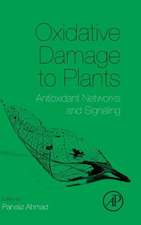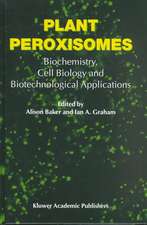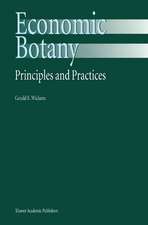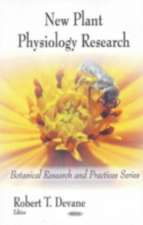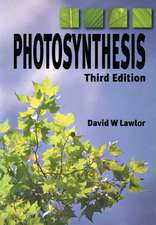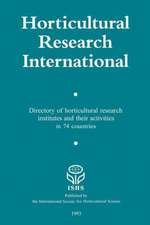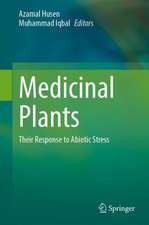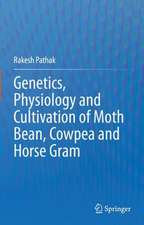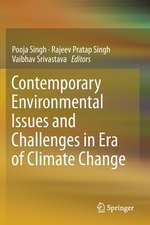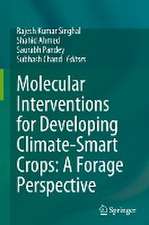Heavy Metal Toxicity: Environmental Concerns, Remediation and Opportunities
Editat de Rajeev Pratap Singh, Pooja Singh, Amrita Srivastavaen Limba Engleză Hardback – 23 sep 2023
This book incorporates classical views along with modern scientific approaches to develop an understanding of the subject matter suitable for academicians, researchers, planners, policymakers, NGOs, and environmental consultancies and raise awareness on this concern. Topics representing diverse sections namely environmental impacts, biological effects, and methods used for detection and remediation have been included to address all possible contemporary issues on the topic in one concise volume.
Preț: 1234.62 lei
Preț vechi: 1505.64 lei
-18% Nou
Puncte Express: 1852
Preț estimativ în valută:
236.32€ • 256.78$ • 198.64£
236.32€ • 256.78$ • 198.64£
Carte disponibilă
Livrare economică 31 martie-14 aprilie
Preluare comenzi: 021 569.72.76
Specificații
ISBN-13: 9789819903962
ISBN-10: 9819903963
Pagini: 440
Ilustrații: XIII, 440 p. 1 illus.
Dimensiuni: 155 x 235 mm
Greutate: 0.93 kg
Ediția:1st ed. 2023
Editura: Springer Nature Singapore
Colecția Springer
Locul publicării:Singapore, Singapore
ISBN-10: 9819903963
Pagini: 440
Ilustrații: XIII, 440 p. 1 illus.
Dimensiuni: 155 x 235 mm
Greutate: 0.93 kg
Ediția:1st ed. 2023
Editura: Springer Nature Singapore
Colecția Springer
Locul publicării:Singapore, Singapore
Cuprins
Chapter 1 - Cadmium toxicity in plants: uptake, translocation and phyto-remediation strategy.- Chapter 2 - Heavy metal/metalloid contamination: Their sources in environment and accumulation in food chain.- Chapter 3 - Heavy metal/metalloid contamination: Impact on human health and mitigation strategies.- Chapter 4 - Heavy Metal Pollution in the Environment: Impact on Air Quality and Human Health Implications.- Chapter 5 - Heavy Metals Contamination in Surface Water Bodies through Construction & Demolition Waste: a case study of city of lakes - Bhopal, Madhya Pradesh, India.- Chapter 6 - Soil Deterioration and Risk Assessment of Heavy Metal Contamination.- Chapter 7 - Heavy metal contamination in ground water: Environmental concerns and mitigation measures.- Chapter 8 - Effect of Heavy Metals on Roadside Vegetation.- Chapter 9 - Heavy Metal Pollution in Atmosphere from Vehicular Emission.- Chapter 10 - Life Cycle Assessment of Heavy Metal Toxicity in the Environment.- Chapter 11 - Metalliferous soil remediation through heavy metal resistant plant growth-promoting bacteria: prospects and paradigms.- Chapter 12 - Phytoremediation of Heavy Metals - Reaction mechanisms and selected efficient technologies of heavy metals contamination.- Chapter 13 - Industrial Wastewater Treatment Strategies.- Chapter 14 - Brassica Juncea L.: A Potential Crop for Phytoremediation of Various Heavy Metals.- Chapter 15 - Phytoremediation of Heavy Metals.- Chapter 16 - Bioremediation of mining sites - sustainable approach to restore healthy ecosystem.- Chapter 17 - Industrial Pollution Management Approach.- Chapter 18 - Harnessing Green Energy Along with Precious Metal Recovery from Wastewater in Bio-electrochemical Systems: A Win-Win Scenario.- Chapter 19 - Minimization of Cadmium Toxicity in Wheat by Exogenous Application of Hydroxamate Siderophore. Chapter 20-Microbial remediation of Heavy Metals
Notă biografică
Dr. Rajeev Pratap Singh works in the area of waste management and has worked on various kinds of wastes, i.e., fly ash, sewage sludge, tannery sludge, palm oil mill waste, contaminated water irrigation, etc. He has many publications in reputed journals on waste management and similar topics. He has been honored with several international awards including “Green Talent” Award from the Federal Ministry of Education and Research (BMBF), Germany; Prosper.Net Scopus Young Scientist Award; DST Young Scientist Award; and Water Advanced Research and Innovation (WARI) Fellowship, a fellowship supported by the Department of Science and Technology (DST), Government of India, the Indo-US Science and Technology Forum (IUSSTF), University of Nebraska-Lincoln (UNL), and the Robert Daugherty Water for Food Institute (DWFI). He has coauthored 4 books and more than 40 highly cited research and review articles on solid waste management.
Dr. Amrita Srivastava holds PhD from the Department of Botany, Banaras Hindu University and works at Central University of South Bihar, Gaya. She works in the area of microbial secondary metabolite applications. Her major interest is in the characterization of microbial secondary metabolites called siderophores. Recently, she has started working on heavy metal stress, specifically arsenic and cadmium stress. The focus of her work lies in the extraction and purification of microbial secondary metabolite siderophores and their application for heavy metal mitigation in crops, bioremediation, and various symbiotic/antibiotic interactions mediated by them. This includes antifungal and anticancer properties of siderophore and physiological effects on plants and other microbes. She has published 23 research and review articles in journals of international repute, edited 1 book, and authored over 13 book chapters.
Dr. Pooja Singh holds a PhD from the School of Industrial Technology, University Sains Malaysia, Penang, Malaysia; an MSc (Biotechnology) from Devi Ahilya University, Indore; and an MTech in Biotechnology from Rajiv Gandhi Proudyogiki Vishwavidyalaya, Bhopal, MP. She is currently a faculty member at ICST, SHEPA, Varanasi. Her current research interests include enzymes, biopulping of oil palm biomass, and vermicomposting using various types of wastes. She has published 18 papers in various reputed international journals, 5 book chapters, and 1 edited book.
Dr. Amrita Srivastava holds PhD from the Department of Botany, Banaras Hindu University and works at Central University of South Bihar, Gaya. She works in the area of microbial secondary metabolite applications. Her major interest is in the characterization of microbial secondary metabolites called siderophores. Recently, she has started working on heavy metal stress, specifically arsenic and cadmium stress. The focus of her work lies in the extraction and purification of microbial secondary metabolite siderophores and their application for heavy metal mitigation in crops, bioremediation, and various symbiotic/antibiotic interactions mediated by them. This includes antifungal and anticancer properties of siderophore and physiological effects on plants and other microbes. She has published 23 research and review articles in journals of international repute, edited 1 book, and authored over 13 book chapters.
Dr. Pooja Singh holds a PhD from the School of Industrial Technology, University Sains Malaysia, Penang, Malaysia; an MSc (Biotechnology) from Devi Ahilya University, Indore; and an MTech in Biotechnology from Rajiv Gandhi Proudyogiki Vishwavidyalaya, Bhopal, MP. She is currently a faculty member at ICST, SHEPA, Varanasi. Her current research interests include enzymes, biopulping of oil palm biomass, and vermicomposting using various types of wastes. She has published 18 papers in various reputed international journals, 5 book chapters, and 1 edited book.
Textul de pe ultima copertă
This contributed volume covers a comprehensive account of the sources, toxic biological as well as environmental impacts, and possible remediation strategies for contamination by heavy metals. In biological systems, toxic metals affect the integrity of cellular organelles and act as carcinogens causing chromosomal aberrations or as systemic toxicants leading to cardiovascular, neurobehavioral, and immunological disorders. In plants, they interfere with photosynthesis, fertility, metabolite, and chlorophyll synthesis. Toxicity induced by heavy metals involves mechanistic approaches that need to be understood properly. They cannot be degraded by biological or chemical means and thus can only be converted to less harmful forms. The conventional detection methods include biosensors, voltammetry, atomic absorption spectrometry, and inductively coupled plasma with atomic emission spectrometry. All such strategies for metal detection and mitigation strategies are covered in this title under one section.
This book incorporates classical views along with modern scientific approaches to develop an understanding of the subject matter suitable for academicians, researchers, planners, policymakers, NGOs, and environmental consultancies and raise awareness on this concern. Topics representing diverse sections namely environmental impacts, biological effects, and methods used for detection and remediation have been included to address all possible contemporary issues on the topic in one concise volume.
This book incorporates classical views along with modern scientific approaches to develop an understanding of the subject matter suitable for academicians, researchers, planners, policymakers, NGOs, and environmental consultancies and raise awareness on this concern. Topics representing diverse sections namely environmental impacts, biological effects, and methods used for detection and remediation have been included to address all possible contemporary issues on the topic in one concise volume.
Caracteristici
Defines all the environmental aspects of heavy metal toxicity including sources and distribution in various systems Covers the biological mechanism of metal toxicity and tolerance among humans, plants, and microbes. Includes classical and modern approaches for the remediation of heavy metals

